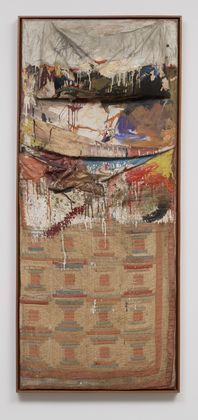Artists Among Poets -Abstract Expressionism
Abstract expressionism was an American post-World War II art movement. It was the first specifically American movement to achieve worldwide influence and put New York City at the center of the western art world, a role formerly filled by Paris. In the US, Alfred Barr was the first to use this term in 1929 in relation to works by Wassily Kandinsky.
During the late 1940s Jackson Pollock's radical approach to painting revolutionized the potential for all Contemporary art that followed him. To some extent Pollock realized that the journey toward making a work of art was as important as the work of art itself. Like Pablo Picasso's innovative reinventions of painting and sculpture near the turn of the century via Cubism and constructed sculpture, Pollock redefined what it was to produce art.
His move away from easel painting and conventionality was a liberating signal to the artists of his era and to all that came after. Artists realized that Jackson Pollock's process—the placing of unstretched raw canvas on the floor where it could be attacked from all four sides using artist materials and industrial materials; linear skeins of paint dripped and thrown; drawing, staining, brushing; imagery and non-imagery—essentially blasted art making beyond any prior boundary.
The Black Mountain Poets
In 1950, Charles Olson published his seminal essay, Projective Verse. In this, he called for a poetry of "open field" composition to replace traditional closed poetic forms with an improvised form that should reflect exactly the content of the poem. This form was to be based on the line, and each line was to be a unit of breath and of utterance.
The content was to consist of "one perception immediately and directly (leading) to a further perception". This essay was to become a kind of de facto manifesto for the Black Mountain poets. One of the effects of narrowing the unit of structure in the poem down to what could fit within an utterance was that the Black Mountain poets developed a distinctive style of poetic diction (e.g. "yr" for "your").
Black Moutain College
Although it lasted only twenty-three years (1933-1956) and enrolled fewer than 1,200 students, Black Mountain College was one of the most fabled experimental institutions in art education and practice. It launched a remarkable number of the artists who spearheaded the avant-garde in the America of the 1960s. It boasted an extraordinary curriculum in the visual, literary, and performing arts as evidenced by some of the artists and teachers listed here:
Its art teachers included Anni & Josef Albers, Eric Bentley, Ilya Bolotowsky, Willem & Elaine de Kooning, Buckminster Fuller, Lyonel Feininger, Franz Kline, Walter Gropius and Robert Motherwell. Among their students were John Chamberlain, Kenneth Noland, Robert Rauschenberg, Dorothea Rockburne, and Cy Twombly.
The performing arts teachers included John Cage, Merce Cunningham, Lou Harrison, Roger Sessions, David Tudor, and Stefan Wolpe.
Among the literature teachers and students were Robert Creeley, Fielding Dawson, Ed Dorn, Robert Duncan, Paul Goodman, Francine du Plessix Gray, Hilda Morley, Charles Olson, M. C. Richards, Ruth Asawa, Arthur Penn, Kenneth Snelson, Stan Vanderbeek, José Yglesias, and John Wieners. Guest lecturers included Albert Einstein, Clement Greenberg, and William Carlos Williams.
Bed - Robert Rauschenberg

Franz Kline- Action Painter
Kline was labeled an "action painter" because of his seemingly spontaneous and intense style, focusing less, or not at all, on figures or imagery, but on the actual brush strokes and use of canvas. For most of Kline's mature and representative work, however, as the phrase goes, "spontaneity is practiced".